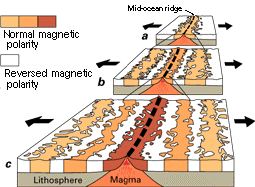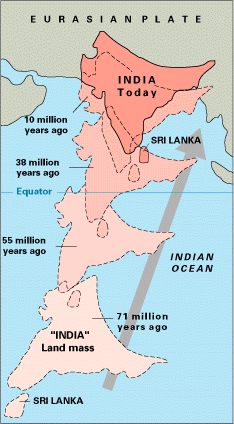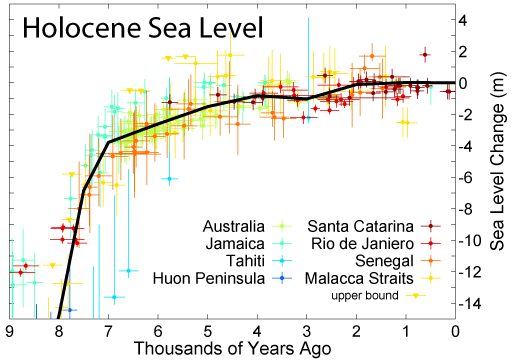Creation Science Rebuttals
Answers Magazine
A Catastrophic Breakup: A Scientific Look at Catastrophic Plate Tectonics
Volume 2, Issue 2 (March 2007)
Review by Greg Neyman
© Old Earth Ministries
Young earth creationists have always had a problem with plate tectonics. In their latest effort to solve this thorn in their side, Andrew Snelling has provided an article for Answers Magazine that examines what he calls Catastrophic Plate Tectonics.1 This article was also the Daily Feature on the Answers in Genesis website on 21 March 2007.
For those who may not know what this is about, the earth’s
crust is divided like a puzzle into many pieces that slide about on
the earth’s surface. To
learn more about this, I encourage you to read about plate tectonics
in the Old Earth Ministries Online Geology Curriculum for home
schoolers,
Chapter 9, Plate Tectonics.
In short, plate tectonics is responsible for building
mountains, such as the
Complaints about Old Earth Plate Tectonics
The first criticism Snelling makes of the slow and gradual
model is magnetic reversals.
The earth’s magnetic field reverses polarity, and this is
seen in the ocean bedrock that is extruded from spreading centers in
the
middle of the oceans. This can
be seen in the graphic at right. As new magma is extruded at
the oceanic ridge, it cools, and the magnetic rock crystals align
according to the current polarity of the earth's magnetic field.
About every million years or so, the field reverses.
Snelling's criticism is that at depth, the farther you drill into
the ocean floor, you no longer see a single polarity, but you see a
mixture of polarities. Snelling claims,
magnetic reversals.
The earth’s magnetic field reverses polarity, and this is
seen in the ocean bedrock that is extruded from spreading centers in
the
middle of the oceans. This can
be seen in the graphic at right. As new magma is extruded at
the oceanic ridge, it cools, and the magnetic rock crystals align
according to the current polarity of the earth's magnetic field.
About every million years or so, the field reverses.
Snelling's criticism is that at depth, the farther you drill into
the ocean floor, you no longer see a single polarity, but you see a
mixture of polarities. Snelling claims,
"This is contrary to what would be expected with slow-and-gradual formation of the new oceanic crust accompanied by slow spreading rates. But it is just what is expected with extremely rapid formation of new oceanic crust and rapid magnetic reversals during the Flood."
However, this is not the case at all.
The diagram shown above is a simplification of the actual process. The oceanic crust is 5-10 miles thick. As noted, when the rock cools, it reflects the polarity at the time of cooling. Rocks extruded on the surface, or close to the surface, cool relatively fast. As you go deeper, the rocks are closer to the upper mantle (lithosphere), thus they are hotter, and cool slower. In fact, since they have a source of heat from below, the lower several miles of the crust would have pockets of molten rock which remain melted for many years. As the crust moves, portions of the lower crust may be re-melted, and re-solidify. The partially melted rock at depth in the crust would contain a record of the polarity at the time it hardened, which could be a time of reversed polarity millions of years after the rocks on the surface of the crust hardened. Thus, when you drill deep core samples, you would expect to see a hodge-podge of magnetic polarity. Contrary to Snelling's claim, this is not evidence of rapid reversals.
Next, Snelling points to sediment at two subduction zone trenches, which he claims should show signs of compression, be deformed, and faulted. Instead, the sediment is flat-lying, and has no compression structures. Of course, we are talking about soft ocean sediments that are water saturated. If you compress it, it reforms, just like a thin mud mixture. Think of it like a runny cake mix. If you pour it into a pan on one side, it spreads out and flattens. In order to get compression features, the mud has to be much drier.
The Catastrophic Model
The model that Snelling discusses was created by Steven Austin, one of his colleagues at the Institute for Creation Research. It starts with a pre-Flood supercontinent, similar to Pangea. Austin "cracks" the ocean floor adjacent to the continent, causing the heavy ocean floor to start sinking into the upper mantle. The images (Figures 3 & 4) show this process. What is interesting is that it roughly shows the accepted Pangea supercontinent. For example, it shows Africa, South America, and North America. However, the continents of Pangea already contain many thousands of feet of sediment that was already deposited, yet in the Flood model these were laid down by the Flood. Which is correct? One young earth model has the rocks already deposited, and the other deposits them in the Flood.
Moving on, the slabs of ocean crust subduct faster, several feet per second. This causes large scale convection currents in the partially molten upper mantle, which produces new rocks at the mid-ocean ridges. Eventually, all of the oceanic crust is subducted, and new crust is in its place. The mid-ocean ridges vaporize water, producing a "linear curtain of supersonic steam jets along the entire 43,500 mi of the seafloor rift zones. He says this may be the "fountains of the great deep" in Genesis 7:11. This water also falls back to earth as intense global rain.
Problems with the Catastrophic Model
The intense global rain comes from the supersonic steam jets. This means that the entire process of catastrophic plate tectonics, and the replacement of the entire ocean floor, must occur within 40 days, for the rain only lasted 40 days. The rain from the steam jets would have continued a few days after the steam jets stopped, so the young earth model would then only have about 35 days to complete this process. Considering a 2,000 mile ocean floor being subducted (some had to be larger than this), that means the rate of subduction would have been an average of about 3 feet per second
Problem #1: Dating
According to the young earth model, all of the sea floor would be about the same age, since they were created in less than 40 days. However, radiometric dating of the ocean floor indicates the age of the ocean floor changes gradually, from brand new at the mid-ocean ridge, to about 150 million years old at the farthest points away from the ridge. This correlates with the rate of spreading and the movement we observe today with the plates. A second method of dating is available. Sediment built up on the ocean floor indicates how old the floor is. The further away from the mid-ocean ridge, the more sediment is present. The sediment build-up is consistent with the old earth model.
Problem #2: Hot Spots
The island chain of Hawaii stretches for thousands of miles. The volcano that formed these islands is known as a hot spot, which is currently fueling the volcanoes on the big island of Hawaii. If the young earth model is correct, then all of these islands, from Midway to the current island of Hawaii, should be roughly the same age. When examined, they show a gradual aging as you go from Hawaii to Midway. Dating of Midway Island gives an age of about 28 million years. Midway is only the midway point of this chain of islands, known as the Hawaiian-Emporer seamout chain. It contains 80 seamounts, or old volcanoes, that stretches over 3,600 miles. These islands could not have formed over the short time frame proposed by the catastrophic plate tectonic model.
Problem #3: Guyots
A guyot is a flat-topped underwater mountain. The tops were eroded flat from being at the ocean surface, prior to them sinking below sea level. The catastrophic model does not give them enough time to form, erode, and sink.
Problem #4: Mountain Building
The catastrophic plate
tectonic model would also cause the continental land masses to
collide, forming mountain ranges. Snelling fails to mention it
in this article. Probably the easiest for people to understand
is the Himalayan Mountain range, which is being formed from the
collision of the Indo- Australian
plate with the Eurasian plate. Today, the Indo-Australian
plate is still moving at a rate of 67mm/year. The
standard geologic model says that 70 million years ago the two
plates started colliding. After the Tethys Ocean between the
two plates was completely closed, about 50 million years ago, the
mountains gradually began to build up. This is why there are
marine fossils near the top of Mount Everest. It is from these
Tethys Ocean sediments.
Australian
plate with the Eurasian plate. Today, the Indo-Australian
plate is still moving at a rate of 67mm/year. The
standard geologic model says that 70 million years ago the two
plates started colliding. After the Tethys Ocean between the
two plates was completely closed, about 50 million years ago, the
mountains gradually began to build up. This is why there are
marine fossils near the top of Mount Everest. It is from these
Tethys Ocean sediments.
The catastrophic model would form most of the mountains in less than 40 days. If the young earth model were correct, then the soft sediments of this ancient ocean would have been rapidly thrust into the air as the mountains built. The rain from the flood would have washed the sediments away rapidly, leaving no evidence of the Tethys Ocean. In fact, when you thrust two masses of mud together, you don't get the jagged peaks we see in the Himalayas...you would get gently rolling hills of mud.
There are many young earth creationists who have long pointed out that the marine fossils at the top of Mount Everest prove the mountain was once covered by the waters of Noah's Flood. However, they leave out one very important point. The marine fossils are in a metamorphosed limestone. The rock was altered after the rock hardened. If they were simply deposited over the top of Everest, there would be a layer of limestone covering the entire area of the mountains. The fossil bearing rock is part of the mountain, and not deposited on top of it.
Problem #5: Carbon Dioxide and Sulfuric Acid
One of the main features of this model is the entire replacement of the sea floor through mid-oceanic ridge spreading, which is basically a volcano underwater. In addition to molten rock, volcanoes emit large amounts of carbon dioxide gas, which is a known greenhouse gas.
We currently have about 400 parts per million of CO2 in our atmosphere. In a study that takes into account the amount of CO2 released by a volcano, geologist Glenn Morton has calculated that the young earth flood model would give the earth an atmosphere that is at a minimum 58,615 parts per million. Global warming scientists are concerned about the temperature rise on the earth if the carbon dioxide level reaches 600 parts per million, but the flood would cause almost 100 times that level. Noah and his family would have been steamed alive, and the ark would become a floating tomb.
Volcanoes also give off large amounts of sulfuric acid, which has an exothermic reaction with water. In other words, sulfuric acid and water combined give off heat, further adding to the greenhouse effect of the carbon dioxide.
Problem #6: Sea Level Rise
Snelling claims that,
As the ocean floor warms during this process, its rock expands, displacing sea water, forcing a dramatic rise in sea level. Ocean water would have swept up onto and over the continental land surfaces, carrying vast quantities of sediments and marine organisms with them to form the thick, fossiliferous sedimentary rock layers we now find blanketing large portions of today’s continents. Rocks like this are magnificently exposed in the Grand Canyon, for example.
Fortunately, we have an excellent record of the sea level over the last 8,000+ years.

As you can see, many data points from 8 different locations gives us a good record of the average sea level. This chart shows that during the supposed global flood, which is dated by young earth creationists to be about 2,300 B.C., or 4,300 years ago, the sea level was approximately one meter less than it is now. There is nothing in any of the historical sea level studies to indicate a vast flood occurred at anytime in earth's recent history.
The other implication of a single sea level rise is that the rock types deposited by Noah's Flood would have looked like a single sea transgression. In other words, there would have been a sandstone, topped by shale and/or limestone, and the reverse sequence as the water receded. Instead, we have in the geologic record many thousands of sea level transgressions, showing that the sea level fluctuated up and down many times over millions of years. There is no evidence that a single great sea transgression occurred.
Problem #7. Dinosaurs
Yes, dinosaurs present a problem for this model as well. Recall Snelling's last quote, in which the sea level rose, bringing the fossils of marine animals over the continental land surfaces. The dinosaur fossils are deposited on top of all the layers of rock that contain only marine organisms. For example, he mentions the Grand Canyon rocks as an example, but there are no fossil dinosaurs in the rocks of the Grand Canyon. You have to go 3,000 feet higher up the rock column to reach dinosaurs. Not only that, but all of the dinosaur trace fossils...the footprints, nest sites, eggs, feeding sites, and dinosaur poop, are all located with the bones. How could the dinosaurs be walking around, pooping, eating, and mating, right in the middle of the great flood?
Conclusion
Although there are other problems, these give you an idea of the irreconcilable problems of the young earth catastrophic plate tectonics model. Interestingly, in Snelling's conclusion, he states that this model is still new. In reality, young earth scientists have been playing with it for the last 45 years, as can be evidenced by Henry Morris mentioning tectonics in his 1961 book The Genesis Flood, although at the time he did not flesh out the idea. The model in its current form stems from at least 1994.2
What is even more telling is that the problems mentioned above have been pointed out to young earth creationists in the past, yet they have failed to address these issues. Why would they ignore issues that completely invalidate their model? The answer to this has to be the intended audience. Answers Magazine is written for young earth creationists. They know they cannot convince real scientists, so they don't need to address these issues. In other words, what their followers don't know, can't hurt them.
1 https://answersingenesis.org/geology/plate-tectonics/a-catastrophic-breakup/
For More Reading/Sources
Plate Tectonics (Wikipedia)
Geology: Plate Tectonics (UC Berkeley)
Young Earth Tectonic Rebuttal (TalkOrigins.org)
Understanding Plate Motions (US Geological Survey)
Geology of the Himalayas (Wikipedia)
Book, The Earth's Dynamic Systems, by W. Kenneth Hamblin
If you are not a Christian, and you have been holding out on making a decision for Christ because the Church always preached a message that was contrary to what you saw in the scientific world, then rest assured that the Bible is the inerrant Word of God, and you can believe in Christ and receive salvation, while still believing in an old earth. Click here for more.
Are you a Christian who believes in young earth creationism? Now that we have shown the many difficulties of the young earth creation science model in this and many other articles, how does this impact your Christian life? If you are a young earth creationism believer, click here.
Answers in Genesis 2007 Daily Features Home
Related Topics
To learn more
about old earth creationism, see
Old Earth Belief,
or check out the article
Can You Be A
Christian and Believe in an Old Earth?
Feel free to check out more of this website. Our goal is to
provide rebuttals to the bad science behind young earth creationism,
and honor God by properly presenting His creation.
